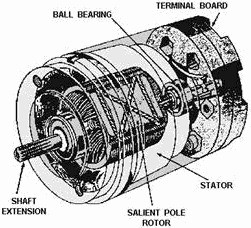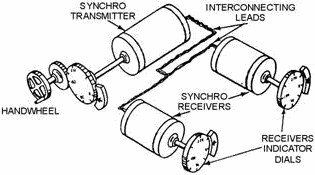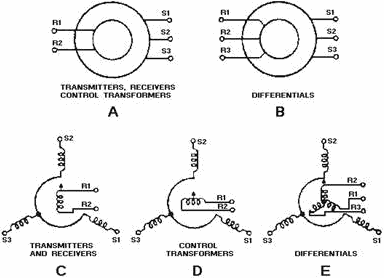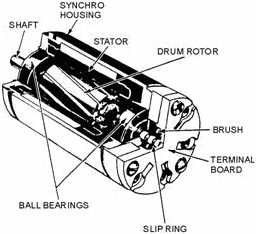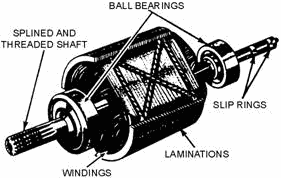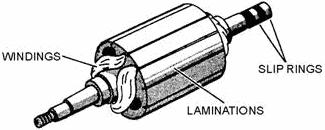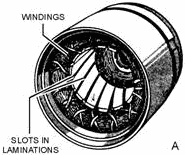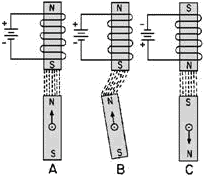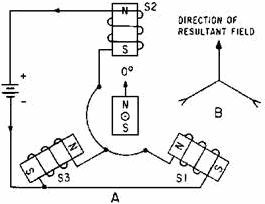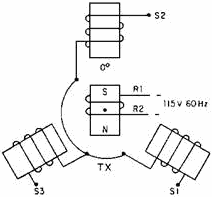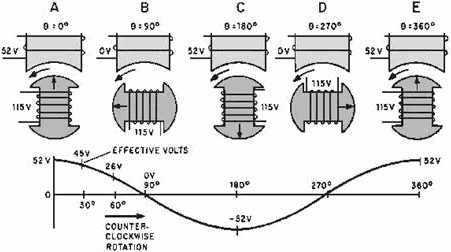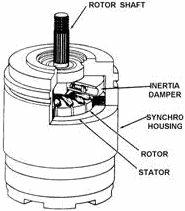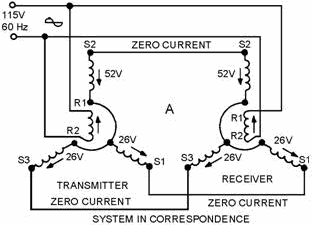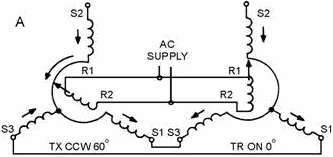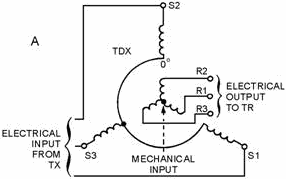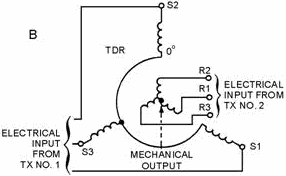Introduction to Test Equipment |
||||||||||||||||||||||||||||||||||||||||||||||||||
|
NEETS Module 15 − Principles of Synchros, Servos, and Gyros Pages i, 1−1, 1−11, 1−21, 1−31, 1−41, 1−51, 1−61, 1−71, 2−1, 2−11, 2−21, 2−31, 3−1, 3−11, 3−21, 4−1, Index
You should now have a good working knowledge of synchro systems. For further study and assistance in applying this knowledge to synchro troubleshooting and alignment, consult the following references:
Pertinent PMS sources:
1. Applicable maintenance instruction manuals.
2. Military Handbook, Synchros, Description and Operation, MIL-HDBK-225A (March 91).
Summary
Now that you have completed this chapter, a short review is in order. The following review will refresh your memory of synchros, their principles of operation, and how they are tied together to form synchro systems.
A SYNCHRO resembles a small electric motor in size and appearance and operates like a variable transformer.
Synchros are used primarily for the rapid and accurate transmission of data. They are also used as control devices in servo systems.
1-61 A SYNCHRO System consists of two or more synchros interconnected electrically.
TORQUE SYNCHRO Systems are systems that use torque synchros to move light loads, such as dials and pointers.
CONTROL SYNCHRO Systems are systems that use control synchros to control servo systems. The servo system, in conjunction with the control synchro system, is used to move heavy loads such as gun directors, radar antennas, and missile launchers.
MILITARY STANDARD SYNCHROS are synchros that conform to specifications that are uniform throughout the Armed Services. They replace the prestandard Navy synchros. a typical example of a military standard synchro designation code is 18TR6A. This code has the following interpretation:
18 - Synchro diameter of 1.71 to 1.80 inches
T - Torque
R - Receiver
6 - 60-Hz frequency
A - Original design
PRESTANDARD NAVY SYNCHROS are synchros designed to meet Navy, rather than service- wide, specifications. a typical example of a prestandard Navy synchro designation code is 5DG. This code has the following interpretation:
5 - Synchro diameter of 3 3/8 to 3 5/8 inches, length
1/2 inches, weight 5 lbs.
DG - Differential transmitter
1-62 SCHEMATIC SYMBOLS for synchros are drawn in two different forms. Two of the five standard military symbols are drawn to show only the external connections to the synchro. The other three symbols are drawn to show both the external connections and the internal relationship between the rotor and the stator.
SYNCHROS ARE CONSTRUCTED like motors. Each contains a rotor, similar in appearance to the armature in a motor, and a stator which corresponds to the field in a motor.
1-63
A SYNCHRO ROTOR is composed of either a single coil of wire wound on a laminated core or a group of coils wound in slots in a laminated core. The laminated core is rigidly mounted on a shaft that is free to turn inside the stator. Two slip rings are mounted on one end of the shaft to supply excitation voltage to the rotor. There are two common types of synchro rotors - the salient-pole rotor and the drum or wound rotor. The SALIENT-POLE ROTOR has a single coil of wire wound on a laminated core, shaped like a dumbbell or the letter "H." This type of rotor is frequently used in transmitters and receivers.
The DRUM OR WOUND ROTOR may be wound continuously with a single length of wire or may have a group of coils connected in series. This type of rotor is used in most synchro control
1-64 transformers and differential units, and occasionally in torque transmitters. When used in differential units, the rotor is wound with three coils so their magnetic axes are 120 degrees apart.
A SYNCHRO STATOR is a cylindrical structure of slotted lamination on which three Y-connected coils are wound with their axes 120º apart.
TORQUE is simply a measure of how much load a machine can turn. In heavy machinery, it is expressed in pound-feet and in torque synchro systems, it is expressed in ounce-inches.
SYNCHRO OPERATING VoltageS and FREQUENCIES vary with different equipment. Synchros are designed for use on either a 115-volt or a 26-volt power source. They also operate on either a 60- or 400-Hz frequency.
ELECTROMagnetic THEORY forms the basis for understanding all synchro operations.
1-65
The RESULTANT Magnetic FIELD in a synchro is the result of the combined effects of three stator fields spaced 120º apart. The stator coil with the strongest field has the greatest effect on the position of the resultant field.
The ZERO-DEGREE POSITION of a synchro, transmitter is the position where the rotor and the S2 stator winding are parallel.
1-66
The SYNCHRO Transmitter (TX) converts a mechanical input, which is the angular position of the rotor, into an electrical output signal. The output is taken from the stator windings and is used by a TDX, a TDR, or a TR to move light loads, such as dials and pointers.
Maximum INDUCED STATOR Voltage occurs in a single synchro stator coil each time there is maximum magnetic coupling between the rotor and the stator coil. This voltage is approximately equal to the product of the effective voltage on the primary, the secondary-to-primary turns ratio, and the magnetic coupling between the rotor and the stator coil.
1-67 The SYNCHRO RECEIVER (TR) is electrically identical to the synchro transmitter. The receiver, however, uses some form of rotor damping that is not present in the transmitter. This real difference between a synchro transmitter and a synchro receiver lies in their applications. The receiver converts the electrical data, supplied to its stator from the transmitter, back to a mechanical angular output through the movement of its rotor.
DAMPING is a method used in synchro receivers to prevent the rotor from oscillating or spinning. There are two types of damping methods - ELECTRICAL and MECHANICAL. The electrical method is commonly used in small synchros, while the mechanical method is more effective in larger synchros.
A TORQUE SYNCHRO System consists of a torque transmitter (TX) electrically connected to a torque receiver (TR). In this system, the mechanical input to the TX is transmitted electrically to the TR. The TR reproduces the signal from the TX and positions either a dial or a pointer to indicate the transmitted information.
CORRESPONDENCE is the term given to the positions of the rotors of a synchro transmitter and a synchro receiver when both rotors are on 0º or displaced from 0º by the same angle.
1-68
Signal is defined as the angle through which a transmitter rotor is mechanically turned. This term has the same meaning as "transmitter's mechanical input."
RECEIVER ROTATION may be in a direction opposite to that desired. When it is necessary to reverse receiver rotation, reverse the S1 and S3 connections on either the synchro transmitter or the synchro receiver. The causes both synchro rotors to turn through the same angle but in opposite directions.
REVERSED ROTOR CONNECTIONS are common problems in new or modified synchro systems and should not be confused with the deliberate reversal of the stator connections. The reversal of the R1 and R2 connections on a synchro rotor causes a 180º error between the synchro transmitter and the synchro receiver, but the direction of rotor rotation still remains the same.
1-69 A TORQUE Differential SYNCHRO System consists either of a TX, a TDX, (torque differential transmitter), and a TR; or two TXs and one TDR (torque differential receiver). The system is used in applications where it is necessary to compare two signals, add or subtract the signals, and finish an output proportional to the sum of or difference between the two signals.
The TORQUE Differential Transmitter (TDX) has one electrical input to the stator and one mechanical input to the rotor. The TDX either adds or subtracts these inputs, depending upon how it is connected in the system, and provides an electrical output from its rotor proportional to the sum of or difference between the two signals.
The TORQUE Differential RECEIVER (TDR) is electrically identical to the TDX. The only difference in their construction is that the TDR has some form of damping. The real difference between the two differentials lies in their applications. The TDR has two electrical inputs, one to the rotor and the other to the stator. The output is the mechanical position of the rotor. As is the case with the TDX, the addition or subtraction function of the TDR depends upon how it is connected in the system.
1-70
|
||||||||||||||||||||||||||||||||||||||||||||||||||
